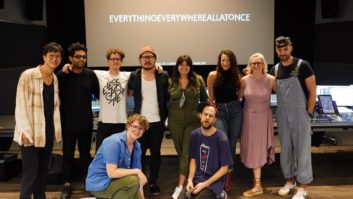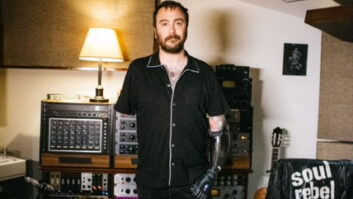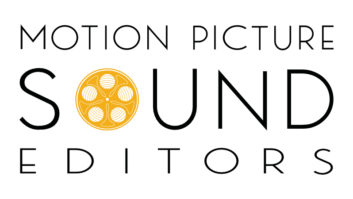Matt Knobel of the Studio at the Setai Hotel
and Resort says the studio’s luxurious
surroundings has meant an A-list clientele.
by Christopher Walsh.

In a second year of recession and some nine months after the “dissolution” of Lehman Brothers sparked a precipitous decline in a multitude of economic statistics, some corners of the Federal government are voicing cautious optimism for a return to growth.
Does this predicted upturn apply to the commercial recording business? Surely, positive economic indicators wouldn’t hurt, but despite the larger economy, an industry battered for several years by a multitude of changes hasn’t given in. Though it may be harder than ever before to successfully operate a commercial audio recording business, many studios are proving that adaptation and innovation can be the keys to success, even in very lean times.
Troy Germano is marking one year of New York-based Germano Studios. “I couldn’t be happier,” says the former CEO of New York’s Hit Factory. “It’s pretty much everything I envisioned it to be.”
Germano equipped his two-room facility with a pair of Solid State Logic Duality consoles and a generous complement of both revered and esoteric outboard gear and plug-ins. “This is more a boutique business at this point,” Germano observes. “With two studios, the clients get a lot of attention, if they need it; if they don’t, they just do their thing. But I think it’s more the size than anything else. The big studios of that nature don’t work: The rooms are too big, there’s too many of them, and it’s not what today’s world is about.
“[Germano Studios] is a little different than the days of the Hit Factory,” he adds, “but there’s a lot more equipment here than at the old place. The rooms are a lot more power-packed, and I think the clients understand that.”
The Studio at the Setai Hotel and Resort in Miami is also in its second year and, like Germano Studios, caters to a high-end clientele. The single-room, SSL C200-equipped studio is situated within both an opulent complex and the larger luxury of South Beach. “Our location is amazing,” says director of operations Matt Knobel. “You can see the ocean from every room. A lot of our clients actually stay in the hotel, so it’s literally like having a studio in your house.” For these reasons, says Knobel, “90 percent of our client list has been A-list. Those kind of clients will always spend money on their projects.”
That said, he adds, “We’re very happy to accommodate budgets. We have a very high book rate, but we will do everything possible to meet any budget.”
The Muscle Shoals Neve 8068, says
GBP Studios’ Glenn Brown, is a big
attraction for clients.Glenn Brown of East Lansing, Michigan-based GBP Studios succeeds despite a distressed regional economy and abundant project studios charging $35-$45 per hour. A lengthy discography, longstanding relationships, diverse service offerings and some choice equipment keep his facility humming, he explains.

“I’ve got the Muscle Shoals Neve [8068] console here, which is a huge attraction, I think, to a lot of people,” says Brown. “It’s probably a lot cheaper to book my room with the Muscle Shoals Neve than a lot of the East Coast rooms with a Neve 8068. The other thing is the success we’ve had in the past. A lot of the people coming here have connected with me in the past. I’ve got a long list of album credits on tons of records. I think it gives us an edge, because people who have worked with me know that they’re going to be able to efficiently do a record. In three or four days they can track and do quite a bit of work in the old-school way of doing records.
“The diversity of the work I do also helps,” Brown adds. “I do tracking, overdubs, mixing, and we’ve been doing mastering for at least 10 years, too. That’s blossomed into a pretty strong business as well–probably 20 percent. I keep busy with a constant onslaught of both Michigan-based bands and people from New York and Boston.”
In addition to the Neve acquired from Muscle Shoals Sound Studios after its 2005 closing (it has since reopened), GBP boasts the Stephens tape machine on which Pink Floyd’s The Wall was recorded, says Brown. “We also have a Studer 827 which people love,” he adds. “I stock a large quantity of tape–we have quite a pile of old-stock Ampex, as well as GP9, as well as new tape.”
For Avatar Studios in New York, maintaining success is about fine-tuning and streamlining existing assets and offerings to adapt to current needs, says president Kirk Imamura. “We’ve had anything from video shoots to cast albums, soundtrack film scores, all kinds of stuff,” he reports. “Some of it is intentional, some we just happened to get. But we’re also thinking about how we can attract film people, what we can do to streamline a cast album.”
Such actions, Imamura allows, are “subtle, and not very obvious or as sexy as saying, ‘We’re going to create this room [and] buy all this gear.’ It’s fine-tuning what we do here.
“We have been finding out,” Imamura adds, “that there is, and always has been, a big songwriting contingent in New York. It seems like more and more people are looking for a room to do songwriting as well as roughs, very quickly. We’re finding that to be another segment. We have a space that we are renovating and thinking of turning it specifically into a songwriting/production room.”
Another successful approach is that taken by Spin Recording Studios in the Long Island City neighborhood of Queens, New York. Forced to move from their existing location, Peter Benjamin elected to keep his studios in the borough of Queens and surround his SSL G/G+-equipped tracking studio with four production rooms, which are rented by locally based engineer/producers.
“Rather than working out of their house, or whatever the case may be, they can be part of a bigger facility, look more professional, and take advantage of our space,” says Benjamin. “These production rooms work really well, because the studio helps them sell their work, their craft, and these guys bring work into the studio as well. They’ll track something in the main room, then go in their room to do editing, overdubs and whatever else. Sometimes, we’ll get the mixes from it.”
Despite a precipitous diminution of project budgets, says Benjamin, “by bringing in all of these production rooms, we’ve opened ourselves up to it, because these guys are still getting a lot of smaller label work that is not going into a full-fledged facility. We’re still getting parts of that work, as opposed to nothing. There’s still work that needs a live room. That was one reason we stayed in Long Island City: the square-foot price. It’s a full-fledged facility–a full-blown SSL, a really large live tracking room, a beautiful grand piano from Bearsville [Studios]. It’s like walking into a city studio, but you’re not looking at city rates.”
Myriad challenges remain, of course. Modern professional recording is often characterized by short-term sessions, for example. “I think that’s the trick: There are more puzzle pieces to fill,” says Germano. “I’ve had a number of clients that have been here for a long period of time, but a lot of other clients have been here for a week. It changes from client to client, but in general, getting people to stay in a studio longer is the trick, and you have to make them very comfortable. So far, so good.”
“A large percentage [of projects], say 50 percent, are just one day, because they’re in town, passing through,” says Knobel of the Setai. “Twenty-five percent is a weekend–three or four days. Then 12 percent is a week to two weeks, and another 12 percent is around a month.”
Clients, says GBP’s Brown, “are spending between $3,000 and $5,000. Two or three times a year, somebody spends $10,000 or $15,000, but it’s mostly that $3,000-$5,000 range, and we’re cranking out a lot of great records on that.”
“I have noticed that clients are paying proper, respectable rates after they understand the value that they receive in a modern 2009 recording studio,” Germano states. “The fact that it is run as a six-star hotel/restaurant with a depth of new equipment, both virtual and physical, that they would never have at home or in the typical threadbare professional studio anywhere in the country these last few years, is a huge calling card for me.”




